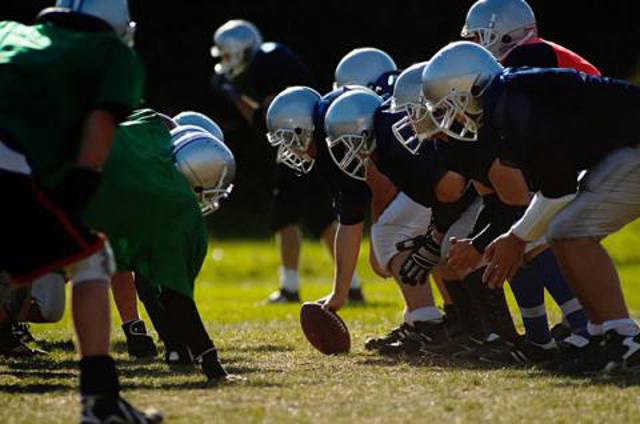Whether photographing amateur or pro games, here are suggestions for getting professional quality photos of Football, American style.
1. Bring the Right Gear
Since most of the play will take place some distance from your position, a telephoto prime or zoom lens is a necessity. Something in the 100-400mm range is ideal, but if you have a shorter lens with a 1.4x or 2x tele extender, that will do the job as well. Those big long lenses with f/2.8 apertures, such as the that the pros use may be out of your budget range, but slower lenses are fine for shooting amateur-level play. A monopod such as the3Pod PM3A is another investment worth making.
2. Dress for Comfort
Football is primarily a cold-weather sport. It takes place in Autumn and Winter, an depending on how late in the season you are shooting and where you are located, you may end up shooting in extreme cold. Protect yourself against the elements—dress in layers, bring photography-friendly gloves so your fingers don’t freeze, and keep your camera gear protected from rain and snow. Keep a spare, fully-charged battery in your pocket (so it can stay warm from your body heat) and if your camera stops working suddenly, swap out batteries. Using a warm battery might revive your camera.
3. Ideal camera settings
If you’re using a slower lens (which you probably will be, unless you have a generous budget for a pro lens), you’ll need to pump up your ISO. Fortunately, most modern MILCs and DSLRs can handle ISO 1000 or higher. The idea is to shoot at a minimum shutter speed of 1/250 sec, although you may want to go to 1/500 or 1/1000 to freeze the action.
4. Use Focus Tracking and Sports Mode
If your camera has focus tracking (most do these days), this is the ideal time to use it. Focus tracking locks focus on moving subjects adjusts focus on them as they move through the frame. This is important when following the ball or keeping up with a Running Back. If your camera has a Sports Mode, use it! This way you can concentrate on the action without worrying about settings.
Photo: Facing off. Photo © StockLite
5. Shoot from the Sidelines
If you’re shooting a high school or informal game, you will have a better chance at positioning yourself along the sidelines so you can photograph the offense and defense facing each other at the field position. Look for the Quaterback shouting commands, the two sides crashing into each other, or a hand-off.
This is where knowledge of the game is essential not just so you can get the most meaningful images, but also for personal safety. You need to keep eyes in the back of your head, just in case play heads full on in your direction. You don’t want to get creamed like this guy. https://www.youtube.com/watch?v=NUuMaemRhxQ
Photo: Pile-up, photographed from the end zone. Photo © Richard Paul Kane/Shutterstock
6. Shoot from the End Zone
One of the best angles for shooting the action is the End Zone. As play moves towards your end, you can focus on the Quarterback as the Center snaps the ball to him. You can also keep an eye on the Running Backs or Wide Receiver as they catch passes and rush towards you, or the Running backs as they try to execute a rushing play. This is where the longest lens is the best lens to get your into the action and Focus tracking will help you a lot.
7. Keep your eye on the Quaterback
The QB is the focus of attention, no matter what level of play. Watch his moves and capture him in action. In this shot of an Intramural Flag Football competition, the photographer has captured both the Quaterback and a player running for a pass. Photo: Tulane Public Relations/Wikimedia Creative Commons
Powder Puff Football action is watched from the sidelines, Bastrop, TX. Photo © Larry D. Moore
8. Look for action on the sidelines
Coaches working on strategy or shouting commands to the team, players sitting on the bench watching the action or showing exhaustion (or enthusiasm) are among the any human interest images you can find. When play is on either end of the gridiron, your view across the field will be unobstructed; that’s a good time to capture the team on the other side on the bench, and the coaches doing their thing.
Also watch the sidelines as the offensive and defensive squads change places. There might be some fleeting interactions as they’re moving on and off the field.
Robbie Gould of the Chicago Bears, kicking. Photo © John Martinez Pavliga/Creative Commons
9 Shoot for Kicks
At Kickoff, and when a team attempts an extra point or field goal, the Kicker is called in. Focus on the holder (or the ball on a Tee) in advance of the kick. At Fourth Down, the punter kicks the ball as well. Both of these kicking situations can yield iconic football images. Shoot from a low angle and as close to the kicker as possible.
If you’re ambitious, try to anticipate where a Fourth Down punt will land, and focus on the players trying to catch it. It’s a tough shot to get, but if you do, it’ll be a “wow” shot.


